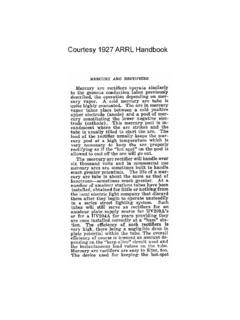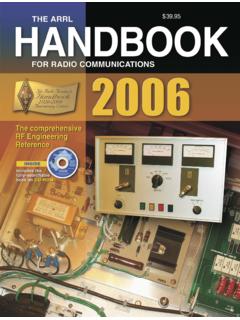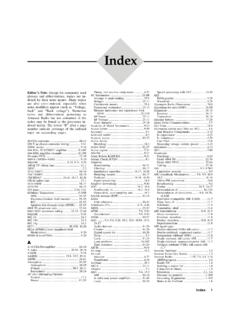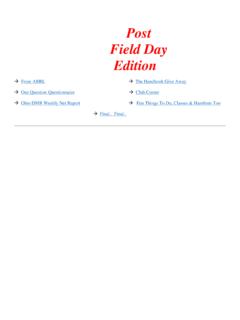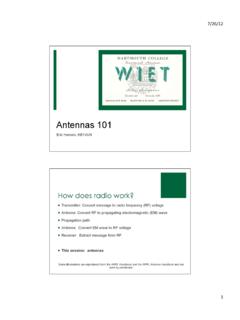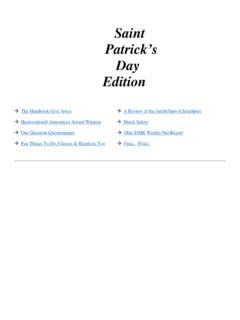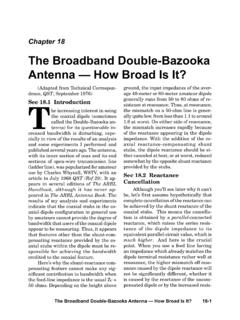Transcription of The ARRL Amateur Radio Emergency Communications …
1 0 PrefaceAmateur Radio Emergency Communications (AREC) is provided by several differenttypes of Emergency Communications organizations. Level I, II and III courses haveaddressed some of these groups specifically. Examples are ARES, RACES, ACS,SKYWARN, SATERN, REACT, etc. It is not the intent of this series of courses to promote any specific group over Amateur Radio Emergency Service (ARES ) sponsored by the american Radio RelayLeague has the longest history of public service of any Amateur Radio emergencycommunications provider organizations. It is also the largest group and is found in almostevery sector of the country. Many other groups are not. Therefore, specific knowledge of theARES organizational structure and the duties and responsibilities of key ARES positions isimportant. Those matters will be discussed in detail in the Level III AREC Courses are specifically intended to provide more emergencycommunications tools to be used as may be appropriate for any given area.
2 What works wellfighting forest fires in Colorado may not work in conjunction with flooding in this information to benefit your community by adding whatever fits your particular areaneeds. Local protocol and training always takes behalf of all the volunteer efforts to put these courses together, thanks for ARRLA mateur Radio EmergencyCommunications CourseLevel IEdited by Dave Colter, , 2:19 PM1 Table of Contents1 Introduction to Emergency Communication2 Amateurs as Professionals The Served Agency Relationship3 Network Theory and the Design of Emergency communication Systems4 Emergency communication Organizations and Systems5 Served Agency communication Systems6 Basic communication Skills7 Introduction to Emergency Nets8 Basic Message Handling Part 19 Basic Message Handling Part 210 Net Operating Guidelines11 The Incident Command System12 Preparing for Deployment13 Equipment Choices for Emergency Communication14 Emergency Activation15 Setup, Initial Operations, and Shutdown16 Operations & Logistics17 Personal Safety, Survival, and Health Considerations18 Alternative communication Methods19 What to Expect in Large-Scale Disasters20 Hazardous Materials Awareness21 Marine Communications22 Other Learning Opportunities23 Modes.
3 Methods, and ApplicationsAppendix AQuiz Question AnswersAppendix BStudent ActivitiesAppendix CReference LinksCopyright 2004-2008 ISBN: 0-87259-846-2 Third Edition, Third PrintingFor error corrections and supplementary material,please check online at , 2:19 PM2 The arrl Amateur Radio Emergency Service (ARES) consists of licensed amateurs whohave voluntarily registered their qualifications and equipment for Communications duty in thepublic service when disaster strikes. The only qualification, other than possession of anAmateur Radio license, is a sincere desire to serve. arrl (and Amateur Radio ) existslargely due to its strong foundation of volunteers. When you join arrl , you support ARESby providing opportunities for those who enjoy volunteering their service and arrl in arrl or any other local or national organization is not required to joinARES or participate in ARES sponsored activities.
4 arrl membership is, however, requiredfor the ARES leadership appointments described here. Through your commitment as anARRL member, you support many national and local initiatives, such as ARES, and helpsupply local volunteers, like yourself, with the materials they need to provide excellentpublic service. To learn more about all of arrl s valuable membership benefits will also find an arrl membership application in the back of this arrl and the Amateur Radio Emergency Service (ARES )Class of LicenseCall SignDate of BirthNameAddressCity, State, ZIPC urrently unlicensed (check here) *A member of the immediate family of an arrl member, living at the same address, may become amember without QST at the special rate of $8 peryear. Family membership must run concurrent withthat of the member receiving QST. Blind amateursmay join without QST for $8 per you are 21 or younger, a special rate may HQ for enclosed Payable to arrl $Charge to: VISA (13 or 16 digits) AMEX (15 digits) MasterCard (16 digits) Discover (16 digits)Card NumberExpiresSignatureIf you do not wish your name and address made availablefor non- arrl related mailings, please check this box.
5 Dues rates subject to change without The national association for Amateur Radio225 MAIN STREETNEWINGTON, CONNECTICUT 06111 USA860-594-0200 FAX: 860-594-0303 Membership Rates Sign me up for a one-year membership at $39 Family* $8 Family Member Blind* $8EC1 Name CallOne-year memberships include $15 for a one-year subscription to and QST cannot be separatedInvitation to , 2:19 PM3 AcknowledgementsThe following people/groups have been instrumental in providing valuable assistance to the is by no means a complete list of contributors. We ve gratefully received too many to name themall. Whether all or part of their material was used in the actual course, or if we simply used theirmaterial as review or reference in what was needed to be covered, we are sincerely grateful to each andevery one for their dedication and willingness to participate.
6 Only with their help, have we been able tocomplete the best arrl training tool for Emergency Communications that has ever been put to everyone who assisted! Cebik, W4 RNLDan Miller, K3 UFGRick Palm, K1 CEPat Lambert, W IPLRon Hashiro, AH6 RHGary Payne N9 VEGreg Jones K3 GJDavid Doane KC6 YSOJoe Dorn W5 VEXPaul Cavnar NN7 BJack Riegel III N5 JAKLyle Meek W6 WFBetsey Doane K1 EICT erry Dettman WX7 SDavid Lane KG4 GIYH arry Lewis W7 JWJRich Slover, ND4 FRob Foshay, W9 VKEldon McDonald, KE4 OCWT aylor Davidson, N4 TDJeff Stidham, KC7 FUYR ichard Werner, K7 UKEd Harris, KE4 SKYR andy Long, W AV VDave Tuttle, NC4 DTTuck Miller, NZ6 TStan Kaplan, WB9 RQRJim Cluett, W1 PIDJ erry Boyd, K6 BZARECC ContributorsPatrick Taber, W5 ABQT erry Busby, W5 ARSArt Feller, W4 ARTP erry Lundquist, W6 AUNR andy Allen, KA AZSPaul Cavnar, NN7 BKelly Bersch, KC7 CSBMark Jewell, KC6 CUBBen Green, WD8 CZPM argie Bourgoin, KB1 DCOB rian Fernandez, KE6 HKJTom McClain, N3 HPRL arry Dunn, N9 HSWR andall Winchester, WD4 HVAMary Lau, N7 IALKen Akasofu.
7 KL7 JCQMark Greene, PhD KD7 JNFS cott Garrett, W8 JSGDave Waltrous, WD2 KJohn Hennessee, N1 KBMax Soucia, N1 KQSFred Stone, W8 LLYRay Moody, AH6 LTSuzy Price, N2 LZRDave Patton, NT1 NRuben Kafenbaum, WA2 NBLJim Andrews, WA NHDNick Leggett, N3 NLF. Dale Williams, K3 PURD ennis Bodson, W4 PWFBob Josuweit, WA3 PZOJohn Evans, N2 QCEB rennan Price, N4 QXLen Koppl, KD Bell, N2 RSIKen Goetz, N2 SQWR osalie White, K1 STOPaul Drothler, WO4 URobert Lunsford, KB8 UEYRich Werner K7 UKPeter Laws, N5 UWYMike Manes, W5 VSIJim Weslager, K3 WRSteve Ewald, WV1 XEd Bixby, AK XDavid Doane KC6 YSODave Colter WA1 ZCNO rganizations that we have received input from.(Please note that the names are in alphabetic sequence.)Colorado Section ARESErie County, PA, SKYWARNF airfax County, VA, , 2:19 PM45 Level 1 Learning Unit 1 Objectives: This unit will introduce you to the general concepts of Emergency communicationand how you, as volunteers, can best preparation required: You should have a sincere interest in improving your skills as anemergency communication to EmergencyCommunicationInforInforInforInf orInformation:mation:mation:mation:matio n:Welcome!
8 As you begin this series of courses, let usfirst thank you for choosing to expand yourknowledge of Amateur Radio emergencycommunication, or emcomm as it is oftencalled. Our professionalism and theeffectiveness of our public service efforts willbe greatly improved if we all share a commonbase of knowledge, skills, and this course, you will learn new skills, andnew ways of thinking about existing the way we have always donesomething is no longer useful or hope that this course will challenge you tobecome the best Emergency may have ideas and material that couldadd to the base of knowledge presented not send these comments to your mentor asyou take the course. Simply make a note ofthem and include them in the course evaluationform you will fill out at the end of the our methods and techniques mustcontinually change to meet the needs of thecommunities we serve, so must this ARECC curriculum committee will makechanges after making careful periodic reviewsof the course, and all student and mentorcomments.
9 A refresher course including thesechanges and other material will eventually beoffered to keep everyone is a communication Emergency ?A communication Emergency exists when acritical communication system failure puts thepublic at risk. A variety of circumstances canoverload or damage critical day-to-daycommunication systems. It could be a storm thatknocks down telephone lines or Radio towers, amassive increase in the use of a communicationsystem that causes it to become overloaded, or thefailure of a key component in a system that haswidespread are easily found. Violent storms andearthquakes can knock down communicationfacilities. Critical facilities can also be damaged in normal circumstances: underground cables aredug up, fires occur in telephone equipmentbuildings, or a car crash knocks down a keytelephone pole. Hospital or 911 telephone systemscan fail. Even when no equipment fails, a large-scale Emergency such as a chemical or nuclearaccident can result in more message traffic thanthe system was designed to handle.
10 Someemergency operations occur in areas without anyexisting communication systems, such as withbackcountry searches or Makes A Good Emcomm Volunteer?Emcomm volunteers come from a wide varietyof backgrounds and with a range of skills andexperience. The common attributes that alleffective volunteers share are a desire to helpothers without personal gain of any kind, , 1:17 PM56 Level 1 Learning Unit 1ability to work as a member of a team, and to takedirection from others. Emcomm volunteers needto be able to think and act quickly, under thestress and pressure of an Do You Fit In? Amateur Radio operators have been acommunication resource in Emergency situationsever since there has been Radio . Someone oncedescribed hams as communication commandos. To the agencies they serve, Amateurs are theirimmediately available communication have the equipment, the skills, andthe frequencies necessary to create expedientemergency communication networks under poorconditions.
